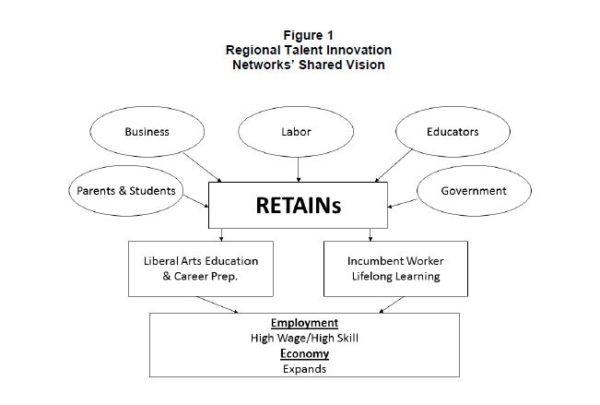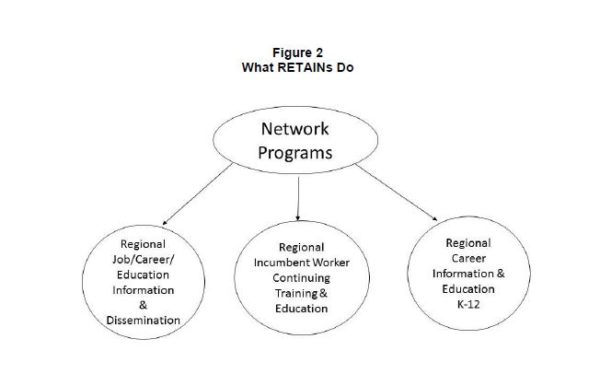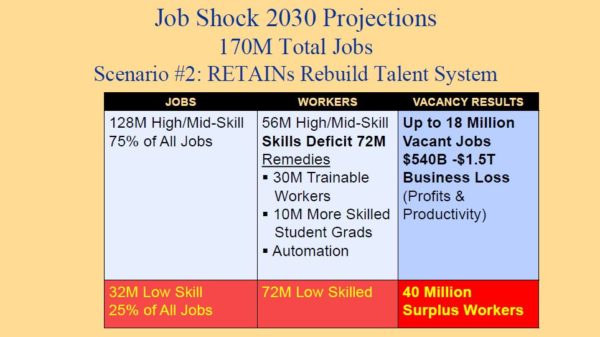The COVID-19 pandemic has triggered widespread doubts about the future. The U.S. job market is in chaos. At the end of April 2021, the U.S. Bureau of Labor Statistics reported an unprecedented 9.3 million job openings across many business sectors. Might this finally be the right time to start anew and find fresh solutions to the skills-jobs shock now underway?
Today’s unprecedented economic upheaval presents an unprecedented opportunity. There are millions of unemployed on the one hand, and rapidly evolving job-skill needs on the other – providing a way for the former to solve the latter’s problem. Communities across the United States have a diversity of underdeveloped talent. They badly need local pathways that promote equity by offering high-quality educational opportunities that are accessible to everyone. This means providing more students and workers with enhanced talent development programs aligned with personal aptitudes and interests and the needs of local businesses and organizations.
The current U.S. labor market is in desperate need of more people who have developed their cognitive, interpersonal, and leadership skills. People who can problem-solve. These people aren’t going to drop from the skies. You can’t click for brains. How can we successfully prepare more people for the skilled jobs of today and tomorrow?
RETAINs
Across the United States at least 1,000 non-profit groups have organized to reinvent local talent-delivery systems. These public-private partnerships bring together a broad cross-section of community groups, such as parent organizations; chambers-of-commerce; elementary, secondary, and higher educational institutions; workforce boards, regional economic development commissions; local government units; unions; service clubs; foundations and other non-profit social welfare agencies.

To provide a descriptive term for such organizations, we coined the term Regional Talent Innovation Network (RETAIN). They have many local brand names, such as The New North, High School Inc., the Vermillion Advantage, ConxusNEO, and Manufacturing Renaissance.
RETAINs began in the 1990s to respond to the economic erosion of their communities. Instead of seeing their young people move elsewhere for employment, they sought to retain them in their communities. Keeping the population stable also enabled communities to retain local businesses and thus stop the erosion of the tax base. Once these communities built a skilled workforce, they could attract new businesses to locate there.
In the short term, RETAINs build a network in which local businesses collaborate with training organizations, educational institutions, and in-house training departments to provide training for vacant jobs and to upskill current employees. This both enables employees to move into higher-skill/higher-paying jobs and enhances the profitability of local businesses through the more efficient use of new technologies. Access to pooled resources makes these training collaboratives particularly beneficial to smaller businesses that cannot afford to provide their own in-house training.
In the long-term RETAINs update educational programs at all levels starting in elementary schools and extending to a wide variety of post-secondary options including certificate and apprenticeships programs. They work to harmonize existing educational programs and devise new ways to fill in skill gaps. RETAINs help reconciles funding streams and secures new revenue to integrate K-12, career education, higher education, and adult training.

We agree with a Wall Street Journal editorial (June 9, 2021) that failing public K-12 schools are the “root cause of America’s skilled-worker shortage.” K-12 schools are locally controlled. The purpose of a RETAIN is to foster communication and cooperation among diverse community sectors. Many students today lack motivation as they find schooling too abstract and unrelated to the “real world.” K-12 students and teachers need active connections to local employers in order to learn about the education and skills required for careers in today’s workplaces. Local businesses need to interact with public and private high school students through sponsoring career education programs, internships, and other activities that allow students to explore career areas that align with their aptitudes and interests.
RETAINs see themselves as joint partners in community building and in the renewal of the U.S. free enterprise system. They are rebuilding the pipeline that connects their community members to the job market. The keywords here are “bottom-up collaboration” – defined as a joint authority, joint responsibility, and joint accountability among all the partners.
RETAINs Can Make a Difference
The good news is what we can expect if RETAINs are instituted across America to rebuild the U.S. workforce.

In 2030 the U.S. economy will support about 170 million jobs; 128 million of them will be high-skill or mid-skill jobs. RETAINs can increase the expected 56 million high/mid-skill workers by retraining 30 million additional workers and preparing 10 million more students for skilled employment.
Combining these job-ready workers with additional automation will reduce the number of vacant jobs across the economy. There still will be a substantial, but not an overwhelming number of surplus workers. However as more communities use the RETAIN model to sustain job-ready workforces, the number will fall. The American middle class will grow again as high-wage employment rises.
Moving Forward
The COVID-19 pandemic has heightened Job Shock in the United States and around the globe. It has disrupted schooling leaving the economically disadvantaged even further behind. Millions of workers have either changed jobs or faced unemployment. Education and training solutions are more vital than ever before. RETAINs can be an important force in preparing students and workers for positions in America’s fast-paced, technologically driven, knowledge economy. Regional development can better support broad economic expansion and ensure that the United States remains a highly competitive global economy.
The next segment of “Job Shock” will focus on local RETAIN case studies. What do they do? How do they succeed? Who supports them?
The monthly Gordon Report Webinars will be focusing on key topics of the “Job Shock White Paper.” For more information on signing up or viewing these webinars, go to www.imperialcorp.com/whats-new/webinars or go to www.MHWmag.com for parts 1, 2, 3, and 4 of this series.
About the Author:
Edward E. Gordon has consulted with leaders in business, education, government, and non-profits for 50 years. Ed is a big picture thought leader connecting the employment dots between business, education, and training. As a historical economist, he applies inter-disciplinary solutions that address the jobs-skills disconnect and related economic development issues. Gordon, the founder and president of Imperial Consulting Corporation in Chicago, is a human capital management expert who is internationally recognized as an authority on how talent delivery systems, career development, and training related to business and economic growth. www.imperialcorp.com











